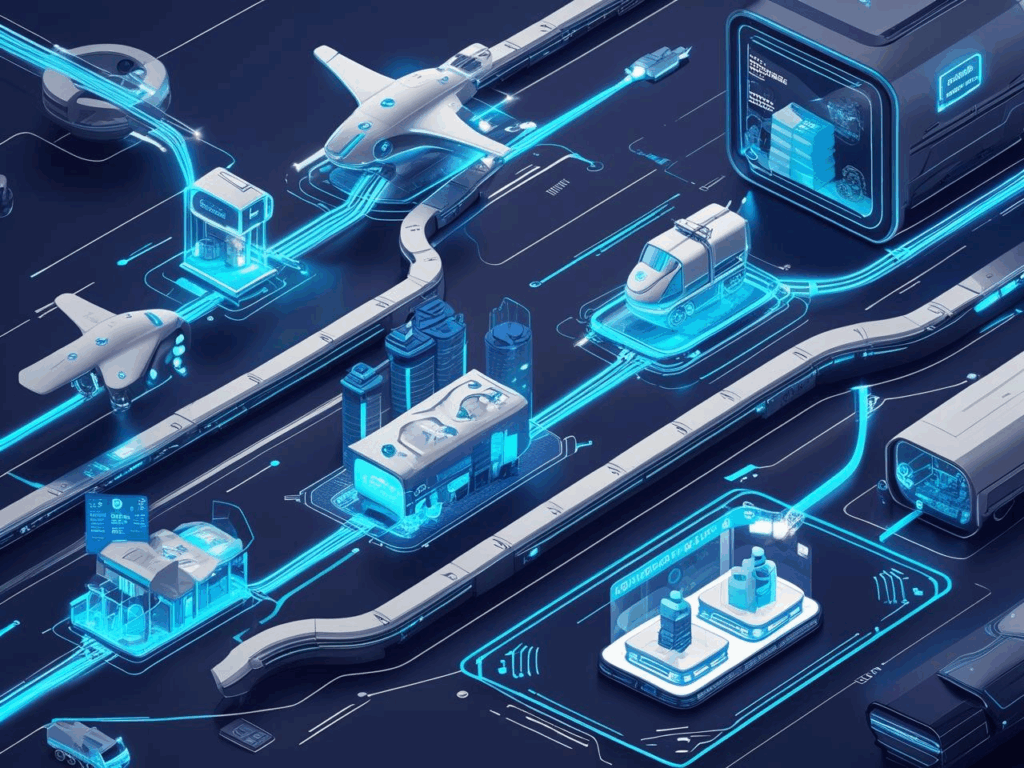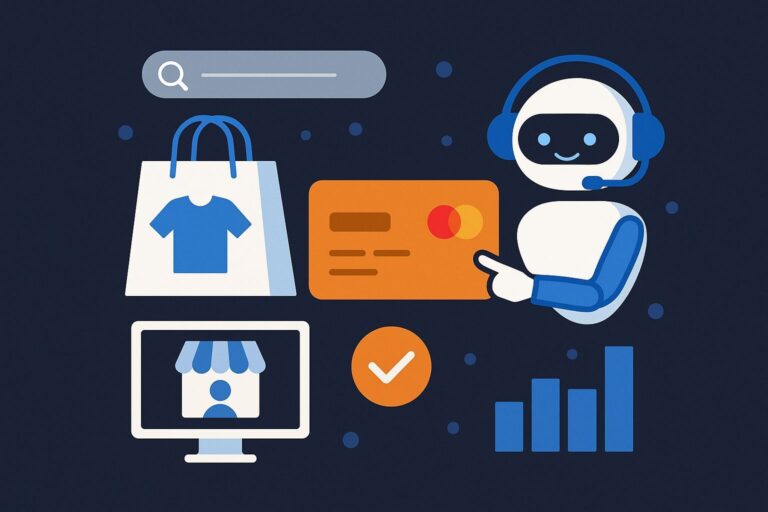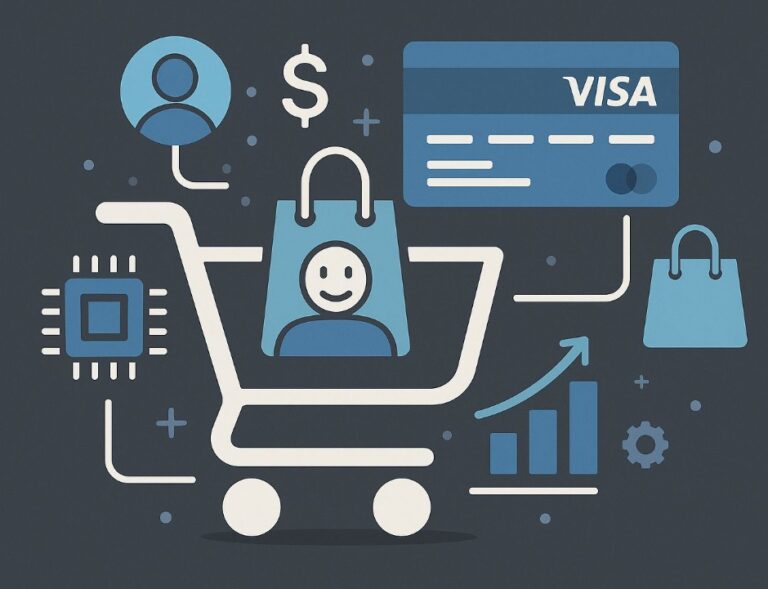The way people find, evaluate, and buy products is changing as we speak, and agentic commerce is at the center of it. According to eMarketer, more than 20% of shoppers already use generative AI for product discovery, meaning that every fifth potential customer is no longer taking the time to shop the old-fashioned way.
As AI agents evolve to act, decide, and transact on behalf of users, all brands must recognize this as a turning point for both ecommerce and in-store transactions. Marketing and operational strategies must be rethought to stay relevant in the agent-centric era.
In this guide, we’ll break down what agentic commerce is, the AI technologies driving it, and how it’s transforming the customer journey. Whether you’re a brand or a buyer, you’ll find practical insights to help you navigate what comes next.
What Is Agentic Commerce?
Agentic commerce is a new model of online shopping where autonomous AI agents act on behalf of consumers or businesses to search, evaluate, decide, and transact. Unlike traditional ecommerce, where users manually browse and click, agentic AI systems use advanced large language models (LLMs), machine learning, and intelligent automation to make proactive, context-aware decisions aligned with user preferences, goals, and limitations.
Dubbed the third wave of commerce by Scott Friend, agentic commerce shifts control from users to intelligent agents that can handle complex tasks such as personalized product recommendations, dynamic price negotiation, automated replenishment, and cross-platform transactions with minimal or zero human intervention.
How Is Agentic Commerce Different From Other Commerce Models?
To accurately illustrate the shift that the agentic commerce era brings to the core mechanics of online shopping, we need to compare it to other commerce models:
| Commerce Model | User Role | Agent Role | Use Case | Marketing Impact on Purchase |
| Traditional Commerce | Users manually search, compare, and buy products. | No agent involved. | User browses the website, adds items to the cart, and checks out. | Marketing drives awareness and purchases directly through ads, SEO, and targeting users. |
| Programmatic Commerce | Users predefine simple rules or conditions. | Agent executes basic tasks based on set conditions. | A smart fridge auto-reorders groceries at a set time. | Marketing must influence the rule-setting phase or product inclusion criteria (such as brand loyalty) |
| Agentic Commerce | Users define intent, preferences, and boundaries. | Agent actively makes decisions and transacts autonomously. | An agent selects, negotiates, and books a vacation based on user-defined preferences such as budget, location, likes and dislikes, etc. | Currently unknown |
As you can see, this isn’t just a technological difference. The main difference lies in who or what drives the transaction.
For consumers, it means more convenience and personalization, as agents act with their preferences and constraints in mind. For brands, it means competing for an AI agent’s recommendation, forcing a reevaluation of marketing, merchandising, and integration strategies to win placement in an automated decision process.
Agentic Commerce—How Does it Work?
Agentic commerce systems rely on LLMs, APIs, and real-time data environments to complete purchases based on user preferences, budget constraints, and contextual goals.
While the underlying technology is sophisticated and complex, for agentic commerce systems to function, the following five systems are often at their core:
- AI agents powered by LLMs that understand natural language, capture user intent, and make decisions on behalf of buyers or sellers.
- Multi-agent orchestration frameworks that coordinate specialized agents to perform (or collaborate on) complex tasks such as negotiation, product comparison, or review parsing.
- Commerce API and backend infrastructure enabling real-time access to product catalogs, inventory systems, CRM data, and payment services.
- Digital identity, trust, and secure payment layers that authenticate agents, enforce zero-trust policies, tokenize financial data, and ensure traceability of every transaction.
Data architecture and memory systems, including knowledge graphs, vector databases, and retrieval-augmented generation (RAG) to give agents contextual reasoning and personalized insight.

1. AI Agents
AI agents are at the heart of agentic commerce. They are powered by LLMs and designed using prompt engineering or fine-tuning techniques to execute digital commerce tasks. As it stands, there are two types of agents we need to be aware of:
- Buyer agents
- Seller agents
Buyer agents represent consumers. They interpret natural language and intent and take autonomous actions based on prompts, such as “Find me rucking boots under $150.”
Seller agents, on the other hand, operate on behalf of merchants to optimize pricing, promotions, procurement, and inventory, and direct responses to buyer agents.
2. Multi-Agent Orchestration
A single agent often cannot complete complex tasks alone, prompting the demand for multi-agent utilization and orchestration. Multi-agent orchestration platforms, such as LangChain, develop, configure, and coordinate agents like:
- Search agents that browse product catalogs.
- Review agents that examine user reviews to identify suitable products.
- Negotiation agents that engage seller agents and APIs to negotiate discounts.
The orchestrator ensures collaboration and manages agents’ workflow, state, and delegation of subtasks for a successful transaction.
3. Backend Infrastructure and APIs
Companies must utilize backend APIs for agents to perform tasks like inventory lookup, checkout, or order confirmation. Some of the most essential APIs include:
- Retailer APIs granting access to real-time product data, availability, pricing, etc.
- CRM and user profile APIs holding data on past orders, preferences, or loyalty data.
- Payment gateways for transaction processing, like Stripe, PayPal, Visa, etc.
Without those, agents would not be able to communicate with digital commerce platforms or websites.
4. Identity, Trust, and Secure Payments
As agents act as autonomous entities on behalf of real users, digital identity, permission management, and secure payment infrastructure are paramount to ensuring safe transactions and an enjoyable customer experience.
First, agents are treated as digital individuals. Each has its own credentials and must operate within a secure framework:
- Each agent is issued unique credentials and time-limited identity tokens that define what it can access and when.
- Agents only gain access to sensitive data or payment authority within a predefined context, such as a single session.
- Every action agents take, from inventory queries to checkouts, is logged for traceability, rollback, and compliance.
This means that every agent is assigned a role-scoped identity, which limits its authority to specific operations and prevents it from going “rogue.” For example, an agent allowed to make one purchase should not retain unfettered access to the user’s finances afterward.
When an agent determines that a purchase aligns with user intent and preferences, it initiates a transaction secured through tokenization. In other words, agents do not hold raw card or payment information to complete purchases. Instead, agents use temporary tokens, issued by financial services providers such as Visa or Mastercard, that turn sensitive financial data into a secure, randomly generated string of numbers and characters to execute agentic payments.
5. Data and Memory Systems
To make intelligent purchasing decisions, agents need context—your past purchases, your preferences, current market status, user reviews, etc. For this to happen, AI companions need access to the following data to reason effectively:
- Structured data like product catalogs, inventory, or prices.
- Unstructured data, such as user or product reviews.
- Real-time data like what’s in your cart or current budget.
In practice, this often means integrating knowledge graphs or vector databases for “memory” and using retrieval-augmented generation (RAG) to access relevant information, so agents can ground their reasoning in up-to-date product and user data.
For example, your agent can remember that your shoe size is 10, you don’t prefer high-tops, and you only shop for items on sale. They will use all that data to search for products that fit all categories.

Benefits of Agentic Commerce
According to recent industry research and data provided by Forrester, BCG, HubSpot, Gartner, and others, brands and consumers stand to benefit a great deal from utilizing AI assistants and agentic commerce in the following ways:
- Excellent return on investment: According to Forrester’s TEI study, companies using AI‑driven personalization (a core component of agentic commerce) achieved a 251% return on investment and $2.3 million in cost savings over 3 years. These numbers are likely to increase with agent-to-agent communication by eliminating buyer friction and indecisiveness.
- Higher conversion rates: After implementing AI-driven product recommendations and messaging, brands saw a 27% increase in purchase likelihood among targeted audiences, according to the aforementioned Forrester’s TEI study.
- Customer service cost savings: According to Gartner, almost 80% of brands use or plan to use chatbots for customer support, which isn’t surprising as AI chatbots can reduce customer service costs by up to 30%.
- Faster issue resolution: An AI agent can resolve issues more than 5x faster than a human agent with an even greater accuracy, resulting in a 25% decrease in repeat inquiries, according to BCG. As we see further developments and more advanced reasoning with AI agents, we can expect that difference to grow even more substantial, necessitating the need for AI agent integrations at every stage of the customer journey.
- Improved customer satisfaction: Businesses report up to an 80% boost in customer satisfaction when AI handles routine support and customer interaction. However, these numbers are related to chatbots, not AI agents. With AI agents on both ends of the transaction, it might be harder to quantify a tangible difference in customer satisfaction. Still, considering the frictionless nature of agentic transactions, we can only assume these numbers will rise even further.
- Reduced cart abandonment: Personalization and real-time assistance from AI can lower cart abandonment rates by up to 25%, recovering lost sales. With further developments in agentic AI experiences, cart abandonment may even become a thing of the past, as agents execute only the most necessary, perfectly optimized purchases on the user’s behalf.
- Increased average order value: With AI agents planning and executing product recommendations or bundles, brands could expect up to a 50% increase in average order value compared to pre-agentic commerce days. In instances where AI agents are tasked with planning events or vacations,
- Improved supply chain efficiency: With AI agents handling negotiations, procurement, and overall inventory and supply chain management, brands can expect maximum efficiency with minimal user involvement. By leveraging customer data or seasonal trends, agent-centric supply chain management could lead to significant monetary gains, including up to 10% lower supply chain costs, 20% lower inventory levels, and 4% higher revenue, according to McKinsey.
- Automatic price adjustments: Real-time, agent-driven pricing strategies can boost profit margins by up to 25% through automated price adjustments based on seasonal trends, demand surges, customer needs, competitor behavior, inventory levels, etc.
- Enhanced fraud prevention: According to Tackle.ai, machine-learning fraud detection, a crucial integration of agentic payment flows, could save up to $48 billion annually by spotting and preventing suspicious transactions in real time.
- Simplified shopping experience: Surveys show that 79% of consumers want AI to help them find promotions, and 86% want AI models to help with product research or information, which is precisely what AI shopping will do for consumers. Additionally, data shows that AI-centric interfaces, even as simple as chatbots, reduce cognitive load and boost consumers’ satisfaction, further simplifying the shopping experience.
What Does Agentic Commerce Mean for Ecommerce?
As AI agents assume the roles of consumers, ecommerce businesses will be poised to rethink their discovery channels, marketing strategies, operational processes, and competitive positioning.
While the changes to the ecommerce industry are likely to be vast and drastic and nearly impossible to predict with utmost accuracy, the major shifts already happening are:
- Potential collapse of the traditional discovery funnel
- Shift to agent-centric optimization
- Automated commerce operations and supply chains
1. Potential Collapse of the Traditional Discovery Funnel
The rise of agentic commerce promises to disrupt the traditional ecommerce funnel, where users organically go through awareness, consideration, and purchase stages. As we mentioned earlier, one in five shoppers already rely on AI for product discovery, and agents are already capable of fulfilling entire orders without humans ever visiting a retailer’s site. In fact, Bernstein analysts Mark Shmulik and Nikhil Devnani warn that “personalized digital assistants” might lead to users bypassing traditional web touchpoints entirely.
This means that brands will no longer compete for clicks but rather for an agent’s recommendation. Does that mean that success hinges entirely on richly annotated, machine-readable product catalogs so that an AI agent can accurately evaluate and eventually recommend the products? No. A lot of people enjoy shopping in its entirety, and that will not change any time soon. However, this will have to become a reality for many brands.
While building trust and human connection will remain a viable strategy, focusing on clear and detailed product descriptions, price, availability, verified reviews, clear return policies, sustainability credentials, and other important metrics will have to become a priority.
2. Shift to Agent-Centric Optimization
Pivot from human-targeted marketing to machine-optimized commerce is bound to happen in the agentic ecommerce era, meaning that if you want your brand to thrive, you will have to redefine your offers, pricing, and incentives to attract virtual buyers.
While agents may be able to browse sale banners, they are more efficient at pulling promotions through APIs and structured formats. This means that the old playbook—polished landing pages, pixel-perfect UI, and visual storytelling—means little to agents parsing structured data and ranking offers at machine speed.
Agents prioritize completeness, clarity, and consistency. They don’t browse. They assess and rank. Your strategy must now be re-engineered to align with the agents’ approach. Every overlooked attribute, a missing spec, a vague return policy, an outdated price, docks your “rank” in an agent’s product scoring engine.
Agents do not respond to brand campaigns but rather to inputs. If your brand doesn’t surface in the AI’s product graph, it doesn’t exist. That means SEO alone isn’t enough. You must engineer data schemas that ensure your product is discoverable, interpretable, and rankable by intelligent agents, and SEOwind’s test clearly shows that. Their implementation of semantic schemas showed a 192% growth of add-to-cart actions and a 278% boost in transactions, which is a clear signal that structured data catches AI’s attention first.
3. Automated Operations and Supply Chains
Automation of supply chains and operational workflows is moving from a competitive edge to a baseline requirement. Platforms like Coupa and Amazon are already integrating AI to automate procurement, predict disruptions, and execute corrective actions without human involvement.
According to McKinsey, companies that integrate AI into supply chain operations can reduce logistics costs by 15%, inventory levels by 35%, and service levels by 65%.
This is exactly what Coupa Navi™ AI agents aim to achieve. Their new suite of AI agents can approve, reject, or negotiate purchase orders based on predefined policies and contextual data.
Amazon’s AI-driven inventory optimization has reduced excess stock by 20% and improved product availability by 15%, saving billions for the ecommerce giant.
This level of automation implies that agentic systems will be able to transact not only on the consumer side, but also across enterprise procurement, vendor selection, and logistics orchestration. That means:
- Seller agents will negotiate with suppliers based on real-time pricing and availability.
- Inventory forecasts will be generated and acted on in real time.
- Customer orders will be routed and fulfilled through AI-optimized logistics nodes with zero human oversight.
With AI-driven commerce in full swing, latency, friction, and error-prone manual interventions are liabilities. Your operations will need to be agent-ready, machine-readable, API-connected, and data-transparent.
What Does Agentic Shopping Mean For Retail?
Retail, just like ecommerce, is shifting toward agentic execution. One of the pioneers of this change is none other than Walmart.
Walmart is developing and deploying task-specific agents to reduce production cycles, streamline merchandising, and automate in-store workflows. For now, the focus appears to be on:
- Labor augmentation: Agents won’t replace workers, but rather they’ll offload repetitive tasks. Walmart employees will use agent-powered tools to plan, stock, and resolve issues faster. Backend agents will coordinate associate tasks, pricing, and stock accuracy, replacing manual oversight with autonomous workflows.
- More efficient supply cycles: Agentic tools will drive real-time inventory decisions. If Walmart’s playbook is to be followed, retailers from all over the world should shift from seasonal to algorithmic demand planning to meet the customer needs.
- Agent-to-agent systems: Shopper-facing agents must integrate with retailers’ internal agents to validate real-time availability, pricing, and fulfillment. Execution depends on this back-end coordination. At the same time, consumers will shape their own agents’ behavior by setting parameters (such as budget, brand, location, etc.) and providing feedback. Walmart plans to enable this by building closed feedback loops—where shopper inputs continuously refine both agent performance and backend decision-making.
If there’s anything to take from this, it’s that the winners in traditional retail will be those who design their systems for agent-to-agent collaboration. These changes will minimize friction, maximize data quality, and optimize decision speed.
What Are the Risks and Challenges of Agentic Commerce?
While agentic commerce promises to transform traditional and online retail as we know it, we also have to be aware of the complex challenges we might be facing, such as:
| Challenge | Explanation |
| Cognitive Limitations | Even advanced LLMs can misunderstand context and produce hallucinations, leading to agent errors such as carts filled with irrelevant items. |
| Memory Poisoning | Autonomous agents will store memories, potentially exposing them to being injected with false information under malicious intent. |
| Privacy Issues | Agents will be required to store private data, such as purchase history or preferences, raising privacy concerns. |
| Adoption Burdens | Implementing agentic commerce won’t be inexpensive. Many brands will be forced to retain staff, overhaul their existing marketing and operational systems, look for new suppliers, etc. |
| Security Issues | Agents may be manipulated through malicious inputs or become attack vectors in data exfiltration or fraud schemes. |
| Brand Bias | Agents may prioritize certain brands due to biased training data, commercial agreements, or optimization models that over-index for popularity or margins. |
Current Applications—Which Companies Are Leading the Charge?
Currently, several companies are deploying agentic shopping solutions for both brands and consumers alike. Those leading the charge are:
- OpenAI launched Operator, an autonomous web‑based AI agent that navigates browsers to perform tasks like ordering groceries, booking travel, and making purchases across platforms like Instacart, DoorDash, and StubHub.
- Amazon launched Rufus, a conversational shopping assistant in its app, trained on Amazon’s product catalog and reviews to support discovery and recommendations. Recently, Amazon also launched Buy for Me, enabling users to purchase items from third-party websites directly within the Amazon app.
- Visa’s Intelligent Commerce platform brings agent APIs for secure, tokenized payments and authentication, enabling AI agents to shop for consumers while enforcing consumer preferences and fraud controls.
- Mastercard Agent Pay provides tokenized, AI-driven payment credentials designed to let shopping agents complete purchases securely.
- PayPal Agent Toolkit integrates with frameworks like LangChain and OpenAI’s Agents SDK, enabling agents to create orders, handle subscriptions, and manage invoices.
- Stripe’s Agent Toolkit lets agents generate single-use virtual cards and integrate usage-based billing in LLM-based workflows.

How Can Ecommerce Businesses Prepare for Agentic Commerce?
With AI agents potentially taking over transactional control in the future, ecommerce businesses will be forced to stop optimizing solely for human behavior and start building infrastructures that agents can work with.
Based on the data we have now, some of the things brands will have to do are:
- Implement structured, machine-readable product data (such as schema markup, rich attributes) to ensure agent discoverability.
- Make product, inventory, pricing, and logistics data machine-accessible through well-documented APIs and structured data schemas.
- Redesign promotions and offers in standardized formats that agents can parse and evaluate autonomously.
- Centralize and standardize customer data using CDPs to generate rich, permissioned behavioral profiles that agents can access to tailor recommendations.
- Audit your first-party data to track preferences, usage, or post-purchase behavior in structured formats that agents can use.
- Enable event-driven architectures so agents can trigger workflows (such as restock alerts, reorder logic, etc.) based on real-time data.
- Adopt semantic and agentic SEO focused on data clarity over aesthetics to ensure product visibility.
- Establish privacy-safe data channels to feed agents user-specific preferences and feedback without compromising compliance.
Run agent-readiness diagnostics to test how your platform performs when accessed via simulated agent workflows.




